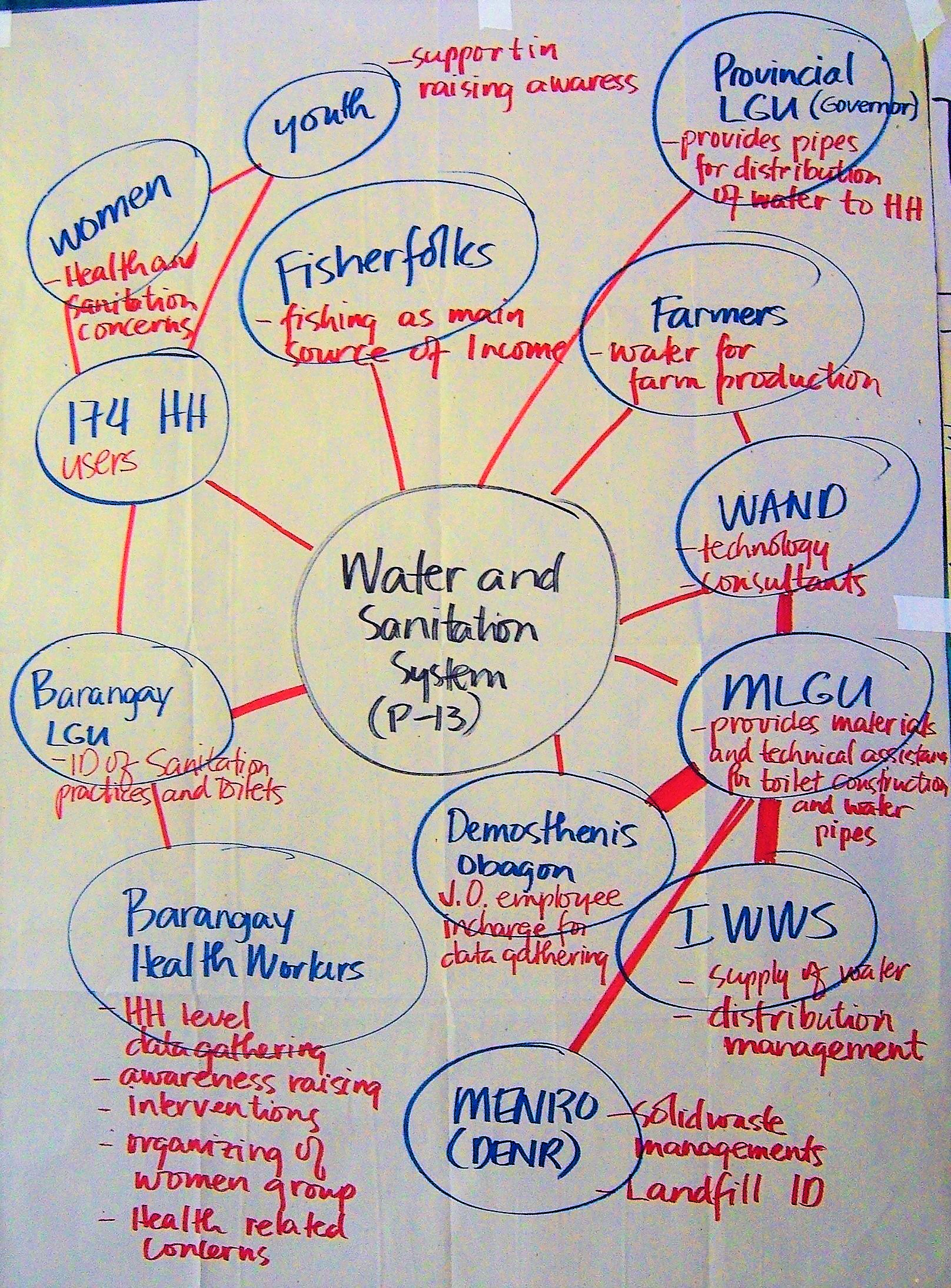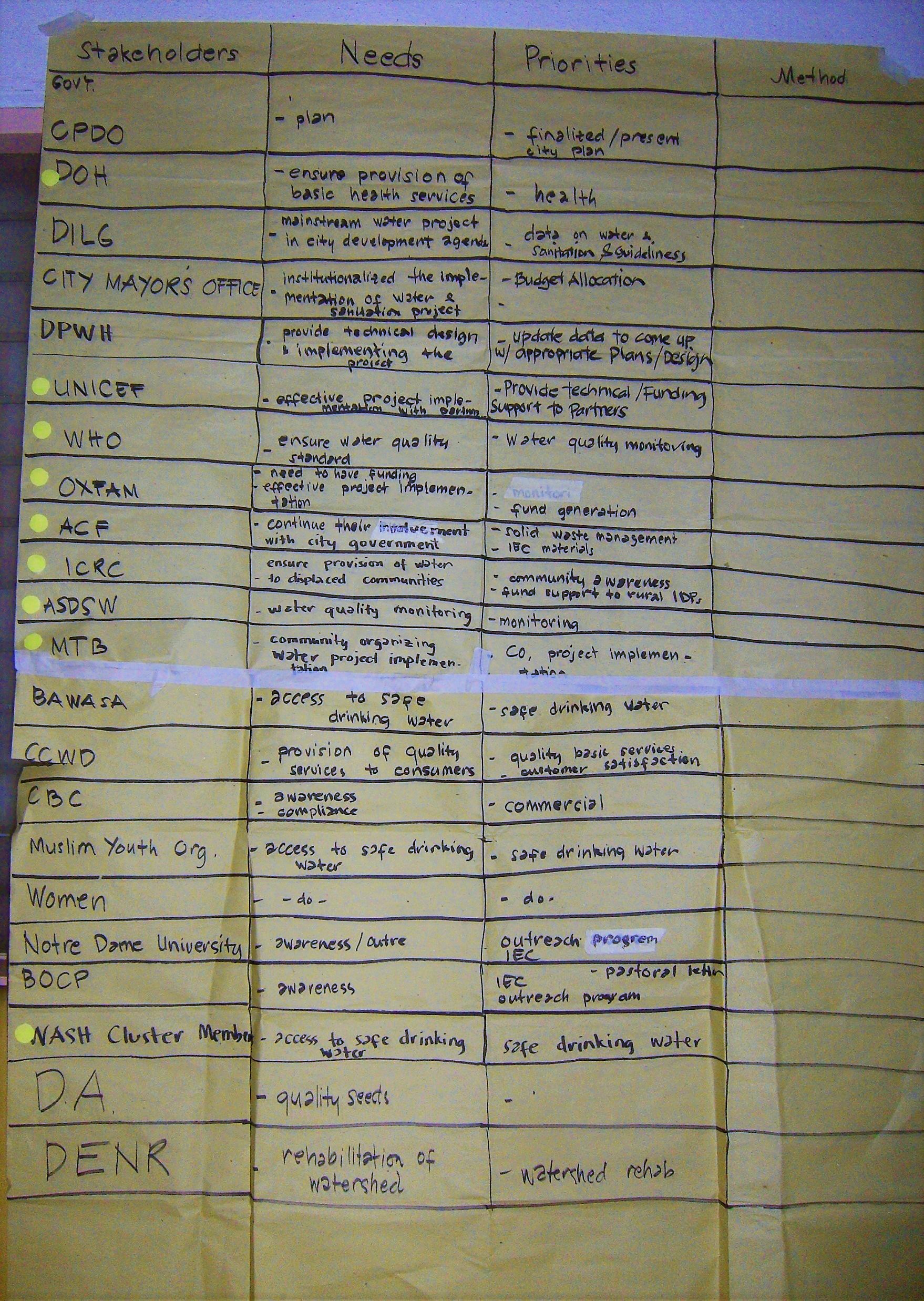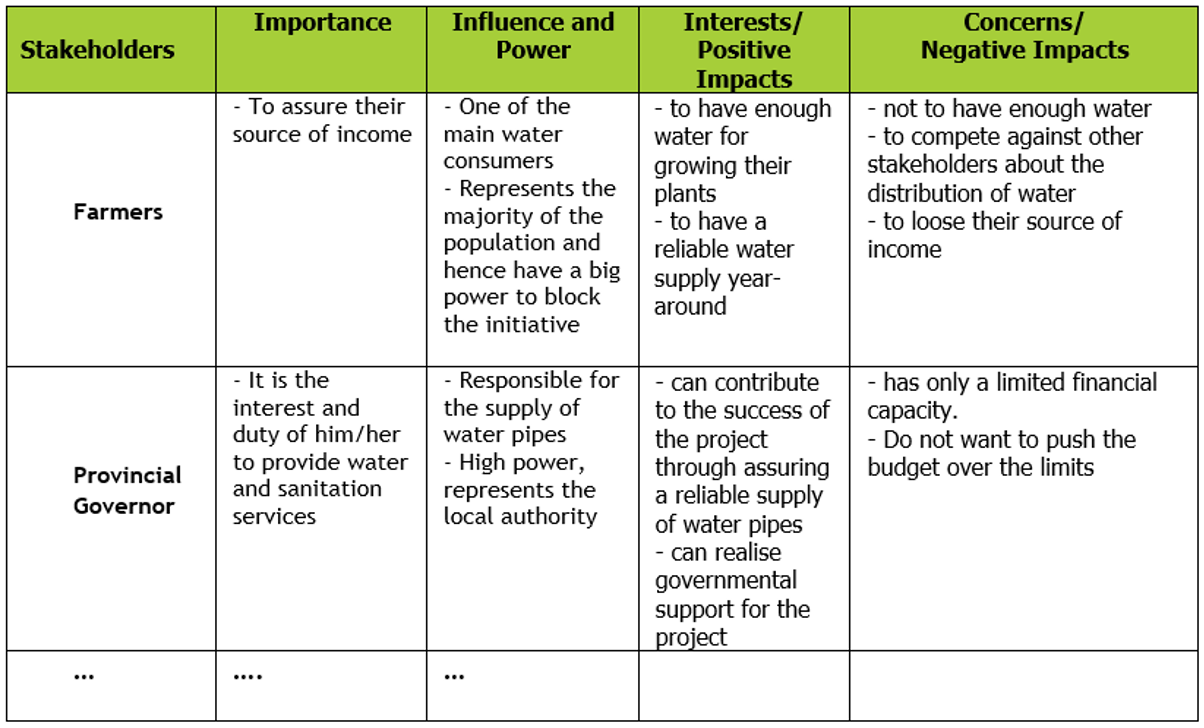Resumen ejecutivo
Participatory planning requires the involvement of concerned stakeholders. This includes identifying public concerns and values and developing a broad consensus on planned initiatives. It is also about utilising the vast amount of information and knowledge that stakeholders hold to find workable, efficient and sustainable solutions (CAP-NET 2008). The stakeholder analysis is the process of identifying and analysing stakeholders, and plan for their participation (RIETBERGEN-McCRACKEN et al. 1998). There are a great number of methodologies concerning stakeholder analysis with a wide range of complexity (see e.g. RIETBERGEN-McCRACKEN et al. 1998; NETSSAF 2008; CAP-NET 2005). Here, we present a four-step methodology, that can be done fully or shortened according to one’s needs: (1) Stakeholder identification, (2) Stakeholders’ importance and influence (3) Stakeholder interests and (4) Stakeholder strategy plan. After identifying the stakeholders and their importance in a next step, the assessment of their interests and the potential impact of these interests on the planned project.
Description
Stakeholders have very different interests with respect to sanitation and water issues. In particular, stakeholders from different levels will have various motives and expectations to a certain project. The specific interests of all types of stakeholders may be difficult to define, especially if they are "hidden", or in contradiction with the openly stated aims of the organisations or groups involved. Interests may be drawn out by asking:
- What are the stakeholder's expectations of the project?
- What benefits are there likely to be for the stakeholders?
- What resources will the stakeholder wish to commit (or avoid committing) to the project?
- What other interests does the stakeholder have which may conflict with the project?
- How does the stakeholder regard other stakeholders? (ODA 1995)
Discussing stakeholders’ expectations, interests and benefits and their concerns or the negative impact an initiative can have on them, respectively, is important for the following reasons:
- To understand stakeholders perception and their point of view
- To avoid forgetting important aspects of involved stakeholders during the planning of SSWM
- To better adjust an initiative regarding stakeholders interests
- To avoid implementation failures and to avoid disregarding the needs and desires of stakeholders
- To focus the planning and implementation right from the start on the needs of stakeholders
- To direct the initiative in the right directive.
There are several possibilities to discuss stakeholders’ interest. The method chosen depends on how former steps of stakeholder analysis were discussed and what kind of overviews for stakeholders identification and stakeholders importance and influence were chosen.
If one has structured the stakeholders as an open map, it is possible to add information about their interest in another colour on the same map (see also Venn diagrams).

Another way to identify interests is to list all stakeholders in a table and add the relevant information.

If a qualitative analysis has already been done in order to find out more about importance and influence, one can simply add more rows to the already existing table to include more information about the stakeholders. See also stakeholders identification.

Note
What kind of information one would like to have for planning of SSWM strongly depends on the context of an initiative. Sometimes, it might be enough to know something about the general role of the different stakeholders at this stage, and sometimes it is worthwhile to gather and discuss further aspects such as stakeholders’ importance and influence or even other aspects which can help to optimise the planning process and to avoid implementation failures at this early stage.
How detailed of an analysis is needed should be decided in the context of the certain project. It also strongly depends on the available timeframe for an initiative.
Subscribe here to the new Sanitation and Water Entrepreneurship Pact (SWEP) newsletter. SWEP is a network of organizations joining hands to help entrepreneurs design and develop lasting water and sanitation businesses.
Stakeholder Analysis Steps
<----- Go back to Step 2: stakeholder importance and influence
Continue with analysing -----> Step 4: stakeholder strategy plan
Or see also:
-----> Step 1: Stakeholder identification
A further detailed analysis of stakeholder interests is applicable for every project. However, a limited timeframe can be a constraint for making a very detailed analysis. Furthermore, in some cases, when the nature of the regarded issue is not so complex, it can be adequate to decide only to make a short and rough stakeholder interest discussion.
Integrated Water Resources Management Plans. Training Manual and Operational Guide
The Cap-Net manual is an introduction to essential parts of integrated water resource management (IWRM). Chapter 2 consists of management planning for IWRM, which provides good information about stakeholder process as well.
CAP-NET (2005): Integrated Water Resources Management Plans. Training Manual and Operational Guide. Pretoria: Cap-Net URL [Visita: 30.06.2019]Integrated Water Resource Management for River Basin Organisations. Training Manual
Capacity Building for Ecological Sanitation
This publication deals with the educational aspects linked to ecologically sustainable sanitation, and contains extensive chapters on capacity building and knowledge management in the field of ecological sanitation.
UNESCO/IHP ; GTZ (2006): Capacity Building for Ecological Sanitation. Paris & Eschborn: German Agency for Technical Cooperation (GTZ) & International Hydrological Programme of UNESCO (UNESCO/IHP) URL [Visita: 15.04.2019]NETSSAF Participatory Planning-Approach
This is the actual tutorial of the participative planning approach developed by NETSSAF, containing all the steps, sub-steps and case studies. It is freely available on the internet in French and English.
NETSSAF (2008): NETSSAF Participatory Planning-Approach. A tutorial for sustainable sanitation planning. Network for the Development of Sustainable Approaches for Large Scale Implementation of Sanitation in Africa (NETSSAF). [Accessed: 29.03.2010] PDFGuidance Note on how to do Stakeholder Analysis of Aid Projects and Programmes
This guidance note provides a step-by-step manual on how to do a stakeholder analysis. Effective strategies for stakeholder participation must be based on good analysis of individuals, groups, and institutions with an interest in a project.
ODA (1995): Guidance Note on how to do Stakeholder Analysis of Aid Projects and Programmes. London: Overseas Development Department (ODA) URL [Visita: 30.06.2019]Carrying Out a Stakeholder Analysis
Participation and Social Assessment: Tools and Techniques
This resource kit aims to share information and experiences on participatory methods in the context of development cooperation. The primary focus concentrates on providing practical guidance and case examples.
RIETBERGEN-McCRACKEN, J. NARAYAN, D. WORLD BANK (1998): Participation and Social Assessment: Tools and Techniques. Washington: World Bank URL [Visita: 10.05.2010]Good Practices in Participatory Mapping
This report explores the power of participatory mapping. Covering a range of techniques, intermediaries, tools and impacts, it is shown how a systematic approach could contribute to addressing conflict-related issues and improving community ownership in sustainable environmental and natural resource management.
IFAD (2009): Good Practices in Participatory Mapping. Rome: International Fund for Agricultural Development (IFAD) URL [Visita: 04.05.2010]Guidance Note on how to do Stakeholder Analysis of Aid Projects and Programmes
This guidance note provides a step-by-step manual on how to do a stakeholder analysis. Effective strategies for stakeholder participation must be based on good analysis of individuals, groups, and institutions with an interest in a project.
ODA (1995): Guidance Note on how to do Stakeholder Analysis of Aid Projects and Programmes. London: Overseas Development Department (ODA) URL [Visita: 30.06.2019]Integrated Water Resources Management Plans. Training Manual and Operational Guide
The Cap-Net manual is an introduction to essential parts of integrated water resource management (IWRM). Chapter 2 consists of management planning for IWRM, which provides good information about stakeholder process as well.
CAP-NET (2005): Integrated Water Resources Management Plans. Training Manual and Operational Guide. Pretoria: Cap-Net URL [Visita: 30.06.2019]Capacity Building for Ecological Sanitation
This publication deals with the educational aspects linked to ecologically sustainable sanitation, and contains extensive chapters on capacity building and knowledge management in the field of ecological sanitation.
UNESCO/IHP ; GTZ (2006): Capacity Building for Ecological Sanitation. Paris & Eschborn: German Agency for Technical Cooperation (GTZ) & International Hydrological Programme of UNESCO (UNESCO/IHP) URL [Visita: 15.04.2019]NETSSAF Participatory Planning-Approach
This is the actual tutorial of the participative planning approach developed by NETSSAF, containing all the steps, sub-steps and case studies. It is freely available on the internet in French and English.
NETSSAF (2008): NETSSAF Participatory Planning-Approach. A tutorial for sustainable sanitation planning. Network for the Development of Sustainable Approaches for Large Scale Implementation of Sanitation in Africa (NETSSAF). [Accessed: 29.03.2010] PDFParticipation and Social Assessment: Tools and Techniques
This resource kit aims to share information and experiences on participatory methods in the context of development cooperation. The primary focus concentrates on providing practical guidance and case examples.
RIETBERGEN-McCRACKEN, J. NARAYAN, D. WORLD BANK (1998): Participation and Social Assessment: Tools and Techniques. Washington: World Bank URL [Visita: 10.05.2010]How to Create a Regional Dynamic to Improve Local Water Supply and Sanitation Services in Small Towns in Africa
Small towns, the size of which can vary from between 3,000 and 30,000 inhabitants, have specific characteristics as they tend to be situated midway between rural and urban. Too small to benefit from those opportunities available to large urban centers, particularly in terms of competencies for developing and managing services, they are also too large to be able to accommodate those community-based approaches prevalent in rural areas. This guide defines the specific issues and challenges facing small towns. A methodology for developing a regional strategy for water and sanitation is provided, as well as the courses of action to be followed to facilitate access to finance and mobilize the expertise required to provide back-up support and training to local authorities and service operators.
VALFREY-VISSER, B. (2010): How to Create a Regional Dynamic to Improve Local Water Supply and Sanitation Services in Small Towns in Africa. (= Six Methodological Guides for a Water and Sanitation Services' Development Strategy , 2 ). Cotonou and Paris: Partenariat pour le Développement Municipal (PDM) and Programme Solidarité Eau (pS-Eau) URL [Visita: 19.10.2011]Getting communities engaged in water and sanitation projects: participatory design and consumer feedback
Community engagement in water and sanitation service delivery is key for ensuring project sustainability and accountability. This Topic Brief looks at community engagement approaches used by WSUP in three cities within the African Cities for the Future (ACF) programme: Antananarivo (Madagascar), Kumasi (Ghana) and Maputo (Mozambique). The Topic Brief highlights some of the key challenges, and ends with practical recommendations for programme managers about how to engage low-income communities in the design of water supply and sanitation projects.
WSUP (2013): Getting communities engaged in water and sanitation projects: participatory design and consumer feedback. London: Water & Sanitation for the Urban Poor (WSUP) URL [Visita: 30.06.2019]Strategy Development for Successful Implementation of Ecological Sanitation Approaches in Sri Lanka using Stakeholder Analysis. Report 3 of 3 from "Evaluation of the Appropriateness of Ecological Sanitation in Relation to the Social, Cultural and Economic
The presented stakeholder analysis provides the necessary information to develop strategies for the successful implementation of ecological sanitation approaches in Sri Lanka.
WINDBERG (2009): Strategy Development for Successful Implementation of Ecological Sanitation Approaches in Sri Lanka using Stakeholder Analysis. Report 3 of 3 from "Evaluation of the Appropriateness of Ecological Sanitation in Relation to the Social, Cultural and Economic. Paris: UNICEF URL [Visita: 18.08.2010]Stakeholder Analysis
This short PowerPoint presentation explains in a brief way how to do a stakeholder analysis and also contains empty tables that can be directly used for analysing stakeholders.
PUBLIC SECTOR IMPROVEMENT FACILITY (n.y): Stakeholder Analysis. URL [Visita: 30.06.2019]Carrying out a stakeholder analysis
This is a very practical, concise and easy to understand set of online guidelines for planning and running training courses. Although the training approaches and techniques described here are based soundly on the sciences of pedagogy and education, they also reflect the practical side of field work in the developing world.

